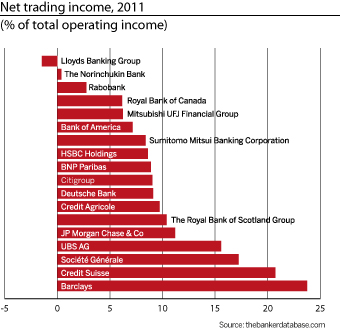The Banker cannot predict which banks will turn out to be involved in the Libor scandal, but we can identify the banks where traders wield the most revenue-generating power.
It would be foolhardy at this stage to try to deduce which banks will turn out to have been involved in the ever-growing scandal over the rigging of the London interbank offered rate (Libor). But what was revealed by the Barclays internal e-mails published as part of the investigation was the considerable power wielded by traders within the bank.
The status of the trading desks is tied to the size of their role in generating income for the bank. The Banker has examined the 18 banks currently on the US dollar Libor panel to see the proportion of net trading income to total operating income in 2011. Of course, this is not in any way a reliable predictor of how the Libor investigations will play out. But it does provide an indication of which banks need maintain a constant focus on governance structures for their traders, given their importance to the bank.
Of the 18 banks, so far only France’s BNP Paribas has not been mentioned as a possible target for investigation into the manipulation of Libor, or its European counterpart Euribor. The bank is not a trading giant, appearing in the bottom half of our chart, with trading income less than 10% of the total. By contrast, Barclays itself comes right at the top of the list, with net trading income equivalent to almost one-quarter of the bank’s total.
Lloyds shareholders claim that the investigation there centres on activities at HBOS, prior to that bank’s purchase by Lloyds at the height of the financial crisis in 2008. If this is accurate, it would be far from the only problematic HBOS legacy at Lloyds, which also had to contend with a net trading loss in 2011 as it continues the process of winding down non-core securities portfolios. However, the precise contribution of the trading desks once Lloyds has completed its overhaul is hard to discern: the bank earned more than $5bn in 2010 in net trading income, the 12th highest in the world.
The obvious odd one out on this list is Norinchukin, Japan’s fourth largest bank, which is hardly a household name in London despite its presence on the Libor panel. It reported net trading income of just $9m for the financial year ending March 2012, less than half a percent of total operating income. The bank is a co-operative that specialises in agricultural finance. So too is the Dutch Rabobank, where trading is also a marginal business, contributing less than 3% to total income.



